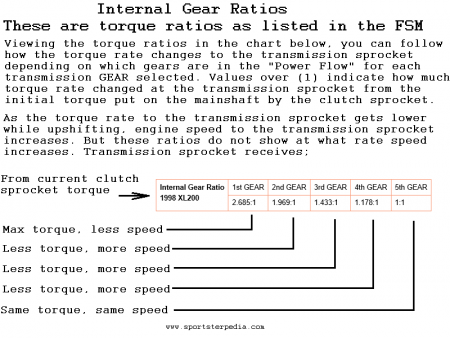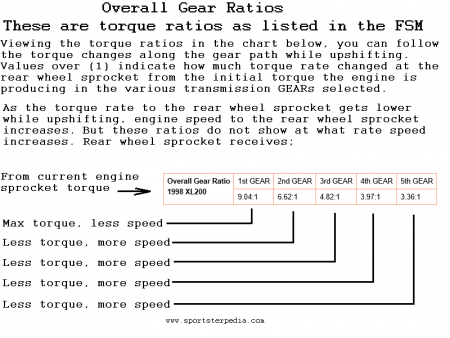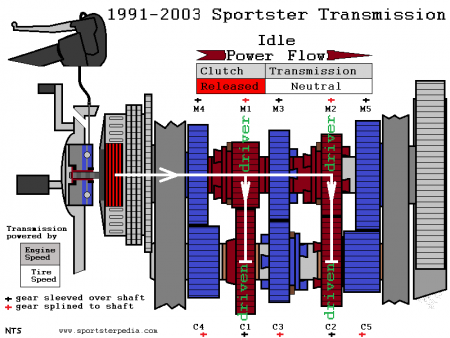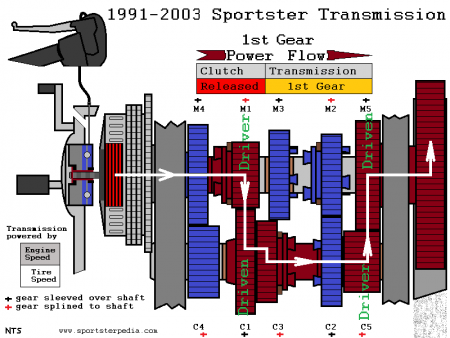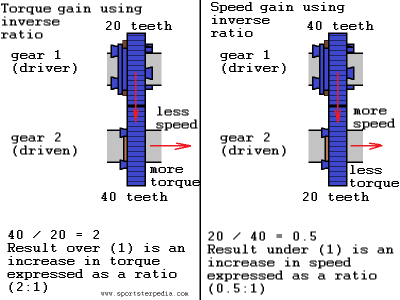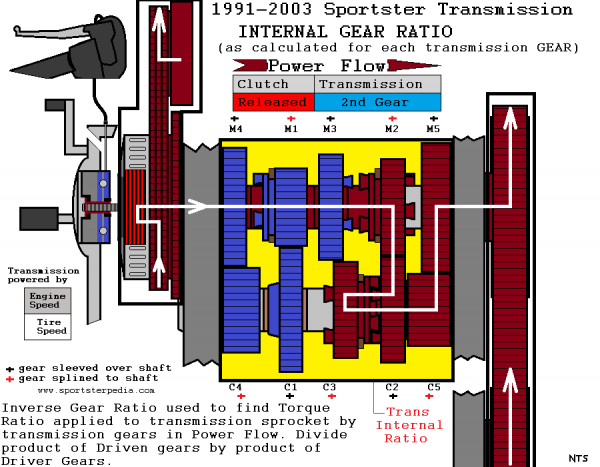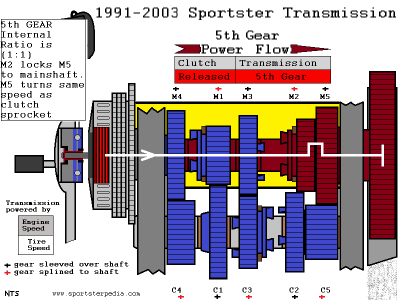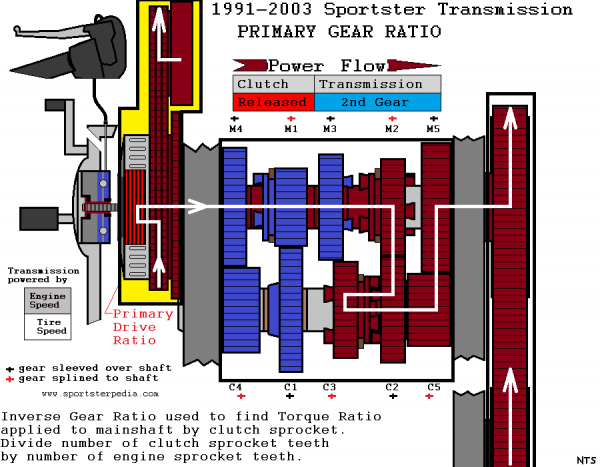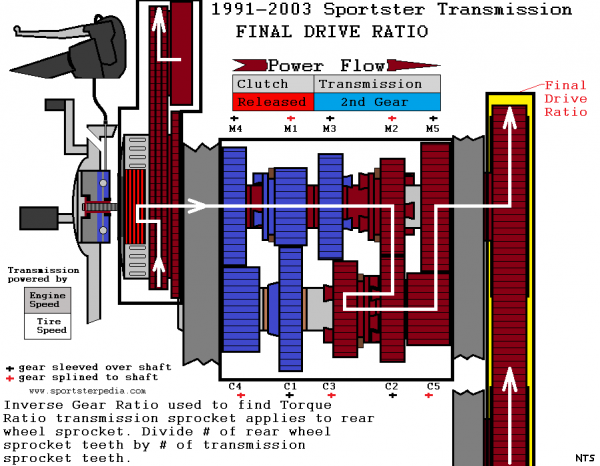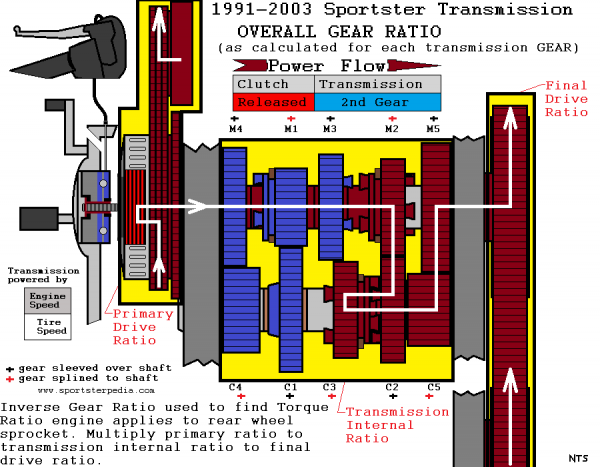Table of Contents
This is an old revision of the document!
REF: Service Procedures 11K
Calculating Gear Ratios
General Information
If you are researching how to calculate gear ratios, it can be confusing since there are several ways to come to the same answer. And once there were general practices that have gotten skewed by the years since. But math doesn't change, only the way you look at it does. Simple math is all that is needed to find the different ratios and information about the gear train. Simple formulas are used to achieve this. The trouble can be which formula to use for what purpose.
Some information regarding car/truck ratios is relevant but a large portion is not due to the different type transmission setups there are as opposed to Sportsters. And some motorcycle information is the same depending on what type/size/make etc. as opposed to Sportsters. Then you eventually start finding engineering information which is more science related to general subjects and you have to pick out what you can from that.
This article intends to at least try and zero in on helpful information to the average Sportster owner.
If there was only one gear on a shaft, there'd be no need to find a ratio. You know how many turns are made based off the RPM of the gear shaft. When you add a second gear and shaft with gear teeth meshed to the first and both are different sizes, one will turn at a different speed than the other. Therefore, their respective shafts will also turn at different speeds.
Worth noting is that the actual power source to the transmission can change during a ride.
The input source to the transmission with the clutch engaged (clutch lever released) is the engine. When you are on the throttle, the motor is driving the transmission and thus the rear tire. The motor is driving the mainshaft and it's gears, and the mainshaft gears are driving respective countershaft gears and thus the rear tire. The input source to the transmission with the clutch disengaged (clutch lever pulled) is the rear tire. When you disengage the clutch, the motor is now not attached to the transmission but the transmission gears still turn. The rear tire is now driving the countershaft and it's gears which turn their respective mainshaft gears. When you let off the throttle with the clutch engaged (lever released), the rear tire is still trying to drive the transmission at the speed the motor was before pulling the clutch. So there is a push/pull going on inside the transmission while riding depending on throttle load.
How to Read Factory Specs
The “Gear Ratios” given in the “Transmission Specification” page in the FSM all relate to Torque, not speed.
It is Harley Davidson that spurs the initial confusion.
The manuals state verbiage like “Internal gear ratios indicate number of mainshaft revolutions required to drive output sprocket one revolution.” This verbiage refers to speed (or RPM) but the ratios listed are all torque ratios. And the service manuals list the different internal ratio values for (i.e. for 883 and 1200) engines. The manuals also state “Overall gear ratios indicate number of engine revolutions required to drive the rear wheel one revolution”. This verbiage also refers to speed (RPM) and the ratios given in the manual are all torque ratios.
If you run the numbers yourself, you'll find the GEAR RATIO does not match the specs they list in the manuals. The gear ratio formula represents a change in speed due to the different number of teeth on the driven gear as opposed to number of teeth the driver gear. So you divide the number of teeth on the driver gear BY the number of teeth on the driven gear and you find how much faster or slower the driven gear turns as opposed to the driver gear. In contrast, using the INVERSE of the GEAR RATIO reveals a mechanical advantage (or disadvantage depending on the result). It represents the leverage (or torque in this application) gained or lost by the teeth count on the driven gear. To calculate mechanical advantage (or torque ratio), you simply reverse the gear ratio formula and divide the number of teeth on the driven gear BY the number of teeth on the driver gear. If you count the gear teeth on the pertaining gears and use the INVERSE GEAR RATIO FORMULA, you'll find that Harley lists the torque ratios for “internal gear ratios” and “overall
gear ratios” in the manuals.
How to read the overall ratios in the FSM; 1)
The internal gear ratio chart shows the rate of how the transmission gears reduce speed and increase torque to the transmission sprocket (accept 5th GEAR).
Changes to the internal ratios (1st-4th GEAR) affect final drive ratios and thus rear wheel torque and speed.
The overall gear ratio chart shows the rate of how the (combined) ratios change engine sprocket torque and speed to the rear wheel. A lower gear provides a greater torque multiplication (drive ratio) between the engine and the rear wheel. Our motorcycles accelerate harder, the lower the gear they are in. Downshifting to a lower gear has the effect of increasing drive ratio and thus increasing the torque multiplication between the engine and the rear wheel. 2)
General Terminology
Gear Ratio vs Inverse Gear Ratio
The standard gear ratio tells you how fast the second gear (driven gear) turns as opposed to how fast the first gear (driver gear) turns.
So you know how fast the first one is turning but now need a ratio of the two gears to find out how fast (or slow) the second gear is turning. Normally, to find the gear ratio, you'll divide the teeth count of the first gear (driver gear) by the teeth count of the second gear (driven gear). Example: A 20 teeth gear is driving a 40 teeth gear. By dividing the first gear teeth by the second gear teeth, you get a number of 0.5 (20 / 40 = 0.5). That means the second gear will only turn at a rate of 0.5 (or 1/2) turns when the first gear has made 1 full turn on it's shaft. And if the RPM of the first gear is turning at 1000 RPM, the second gear is turning at 500 RPM (1000 x 0.5 = 500).
The inverse of the gear ratio tells you how fast the first gear (driving gear) turns as opposed to how fast the second gear (driven gear) turns.
Now if you divide backwards instead, teeth count of the second gear divided by the teeth count of the first gear, you'll get a number that represents how much faster the first gear is turning as opposed to the second gear. So now the formula changes and you do the math to get (40 / 20 = 2). That means the first gear is turning 2 times when the second gear has made 1 full turn on it's shaft. And the speeds are the same between them. The RPM of the first gear is still turning at 1000 RPM and the second gear is still turning at 500 RPM (1000 / 2 = 500).
The inverse of the gear ratio also shows the torque ratio (or mechanical advantage) achieved by the certain gears paired together.
(which represents a change in torque or speed where the driven gear is either smaller or larger in teeth count than the driver gear and to what degree).
The power from the source “is what it is” and can only be changed by more or less throttle (or engine RPM). However, that power can be manipulated to either achieve more torque or more speed (but not both) further down the gear train by changing the gear ratios. The total power stays the same, from the conservation of energy (the law of conservation of energy says that energy is neither created nor destroyed. When people use energy, it doesn't disappear. Energy changes from one form of energy into another form of energy.) 3)
The mechanical advantage is a representation of leverage (or torque) gained or lost from gear ratios and is expressed in the form of a ratio.
These 2 different ratios above are generally not distinguished apart from each other or at least not enough.
As is shown, each result points to one or the other's gear speed although the result is to the relationship between both gears. The difference is in the calculations and which gear or gearset is being referred to.
Driver Gear vs Driven Gear
Determining which is which is crucial in calculating the gear ratio.
When the teeth are meshed together on the 2 separate shafts, one gear drives the other. The gear making the other move is called the driver gear and the other gear is being driven (thus driven gear). The driver gear is closest the power source. The power source is the engine by way of the engine sprocket (driver) which drives the mainshaft by way of the clutch sprocket (driven). The mainshaft receives power from the engine by way of the clutch. The clutch is between the engine and mainshaft and acts more like an on/off switch. With the clutch engaged, the mainshaft receives power from the engine. With the clutch dis-engaged, the mainshaft does not receive power from the engine. The mainshaft drives the countershaft in 1st-4th GEAR and the countershaft drives the M% and thus the transmission sprocket. And in 5th GEAR, the mainshaft drives M5 and thus the transmission sprocket, taking the countershaft out of the power flow.
In the (left) drawing below, there are only 2 gears that are splined to the transmission mainshaft (M1 and M2 gears). The other 3 gears on the mainshaft are sleeved over bearings on the shaft and have to be locked to the mainshaft by way of either M1 or M3 in order to turn the shaft. There are '+' signs above/below each gear in RED or BLACK. Such as M4 has a BLACK '+' and C4 has a RED '+' and M1 has a RED '+'. The BLACK '+' gears are SLEEVED over the shaft on which they are located. This means they can turn separately from the shaft unless otherwise engaged. The RED '+' gears are SPLINED to the shaft on which they are located. This means they always turn whenever that shaft turns. Both M1 and M3 are sliding gears (as is C3) and they are moved by way of the shift forks when you move the shifter pedal.
M1 and M2 (in Neutral) are the driving gears and they are both driving their respective counter gears (C1 and C2). Neither C1 nor C2 are splined to the countershaft, they just sit there and spin while the transmission is in Neutral. So power stops there and allows the bike to idle without being “in GEAR”
In the (right) drawing below, M1 and M2 are still moving and turning their respective gears but now the power from the engine is being used to turn the engine sprocket (to rear tire) so the emphasis is on that flow of power. M1 is (driving) and C1 is being (driven). C1, being sleeved on the shaft, is locked to the countershaft by C3 which makes the countershaft turn. Following the flow of power,C5 is splined to the countershaft and turns when the shaft turns. However, the mainshaft 5th gear (M5) is sleeved and can't turn on it's own. With C5's teeth in constant mesh with M5, C5 is (driving) and M5 is being (driven).
M5 is splined to the transmission sprocket which turns when M5 turns. The transmission sprocket drives the rear wheel sprocket. 4)
Torque vs Speed
The gear ratio shows the trade-off between torque and speed. Speed is RPM and Torque is PUSH. 5) RPM is what is needed on the highway and Torque is the ability to move the bike faster from a stand still. Progressively through the upper gear changes, torque is lowered and speed is gained through gear ratio changes. As with the 2 gear train mentioned below;
If the driving gear is smaller than the driven gear, the result is the driven gear turns slower (less speed) but with (more torque) applied downstream of it.
If the driving gear is larger than the driven gear, the result is the driven gear turns faster (more speed) but with (less torque) downstream of it.
Example: A 20 teeth gear is driving a 40 teeth gear. The input speed is 1000 RPM and the input torque is 50 ft/lbs.
Using the gear ratio (20/40 = 0.5:1), the output speed was reduced to 500 RPM (1000 x 0.5 = 500).
Using the inverse gear ratio, (40/20 = 2:1) then multiplying the example input torque (50 ft/lbs) by the result, (50 x 2 = 100 ft/lbs).
So the output speed was cut in half by this gearset but the output torque doubled (this does not take into account efficiency loss).
However adding gear efficiency, ex. 99% for a spur gears, the formula changes to (40/20) x 50 x .99 = 99 ft/lbs of output torque.
The same mathing applies if the driver gear has more teeth than the driven gear. The results are just in reverse.
Formulas
- Gear Ratio for 2 gears = (number of teeth on driving gear) / (number of teeth on driven gear)
- Gear Ratio for 4 gears = (number of teeth on driving gear x number of teeth on driving gear) / (number of teeth on driven gear x number of teeth on driven gear)
- Inverse Gear Ratio for 2 gears: = (number of teeth on driven gear) / (number of teeth on driving gear)
- Inverse Gear Ratio for 4 gears: = (number of teeth on driven gear x number of teeth on driven gear) / (number of teeth on driving gear x number of teeth on driving gear)
- Output Speed = (input speed) x (gear ratio)
- Output Torque ratio for 2 gears = (number of teeth on driven gear / number of teeth on driving gear)
- Output Torque ratio for 4 gears = (number of teeth on driven gear x number of teeth on driven gear) / (number of teeth on driving gear x number of teeth on driving gear)
- Output Torque = (input torque) x (output torque ratio)
- Power[hp] = torque[lb-ft] x RPM ÷ 5252
Examples of Gear Ratio Calculations
Ratios for 2 Gears Only
The information below shows how to calculate the numbers for a gear train using only 2 gears.
Instead, you can find a gear ratio calculator online to do the math for you.
Click Here to link to one that gives you gear ratio, mechanical advantage, output speed and torque by inputting known values.
The examples below are using a MS-2 (29T) and a CS-2 (34T) gearset (or gear train). Engine RPM at constant 1000 and initial torque of 50 ft/lbs.
In this gearset, M2 is splined to the mainshaft, turns the same speed as the mainshaft and serves as the driving gear of the set.
C2 is sleeved over bearings on the countershaft, has to be coupled to the countershaft by the dogs on C3 gear and serves as the driven gear to M2.
These are arbitrary combinations just for example.
- Gear Ratio = (number of teeth on driving gear) / (number of teeth on driven gear)
- Example: A 29 teeth gear is driving a 34 teeth gear at a ratio of 0.85:1
Plug the numbers into the formula (29 / 34) = 0.85294 (or 0.853)
The result is expressed in ratio as 0.853:1 (or 0.853 to 1).
In this example, CS-2 turns (slower) and at 0.853 times for MS-2 to turn 1 full revolution.
While this setup shows a gear reduction in terms of speed, it creates an output that has more torque when compared to the input torque between these 2 gears.
- Output Speed = (input speed) x (gear ratio)
- Example: Given a mainshaft speed of 1000 rpm using the gear ratio above (0.853), the countershaft speed is 853rpm
Plug the numbers in the formula (1000 x 0.853) = 853
In this example and with a constant input rpm, the countershaft (by way of CS-2) has a speed of 853 rpm.
- Mechanical Advantage = (number of teeth on driven gear / number of teeth on driving gear)
- Example: A 34 teeth gear is being driven by a 29 teeth gear at a mechanical advantage of 1.172:1
Plug the numbers into the formula (34 / 29) = 1.172413793103448
In this example, the result is expressed in ratio as 1.172:1 (or 1.172 to 1).
This example gives 0.172 times more output torque as compared to the input torque between these 2 gears.
- Output Torque = (input torque) x (mechanical advantage).
- Example: Given an input torque 50 ft/lbs, the output torque will increase to 58.6 ft/lbs @ 1000 RPM between the example gears
Plug the numbers into the equation (50 x 1.172) = 58.6
In this example, the torque from the mainshaft was increased on the countershaft by 8.6 ft/lbs (by way of CS-2).
Internal Gear Ratio (4 gears)
Internal ratios are calculated per each transmission GEAR selected.
There are a total of 5 ratios that make up the internal ratio (1st-5th transmission GEAR) and they are calculated individually.
However, Sportster transmissions have an internal ratio of 1:1 in 5th gear so it doesn't need calculating further.
Click Here to see the gearing chart in the Evo section “Primary/Transmission/Final Gear Ratios”. The internal ratios are listed for 1986 and up Sportsters.
This section shows how to calculate internal ratios for yourself.
You must already have gear teeth counts for all the gears in the transmission to calculate the internal ratio.
You can find a gear ratio calculator online to do the math for you if desired but you still need all teeth counts to use it.
Click Here to link to one that gives you internal gear ratio and output speed by inputting known values.
The information below shows how to calculate the numbers for Transmission GEAR 1st-4th. These all use 4 gears (2 drivers and 2 driven) to turn the transmission sprocket.
The engine sprocket and clutch sprocket is not included since they are part of the Primary Drive Ratio which is calculated separately.
The transmission sprocket and rear wheel sprocket is not included in these calculations since they are part of the Final Drive Ratio which is calculated separately.
The internal ratio, (AKA, gearbox ratio), includes the mainshaft and countershaft gears that are in the power flow for the transmission GEAR selected.
The example illustration below shows the gears colored red in the Power Flow for 2nd gear.
Note, C3 is in red only because it takes C3 gear dogs to lock C2 gear to the countershaft.
This example uses the stock gears from a 1998 XL1200; M2 (29T) - C2 (34T) gearset and C5 (25T) - M5 (42T) gearset.
M-2 gear is driving C2 gear and C5 gear is driving M5 gear. Use the inverse gear ratio for each gearset.
You may see the word “gear ratio” elsewhere but this article wishes to distinguish the difference for clarity.
Using the inverse ratio, the result will show the amount of torque gained or lost in the listed internal gear ratios per GEAR selected.
- Inverse Gear Ratio = (driven gear teeth x driven gear teeth) / (driver gear teeth x driver gear teeth)
- Assemble gear teeth count for each gearset:
- Driven Gears: C-2 (34T) and M-5 (42T)
- Driver Gears: M-2 (29T) and C-5 (25T)
- Plug the numbers in the formula:
- (34 x 42) / (29 x 25) or (1,428 / 725) = 1.969655172413793
- The result is expressed in ratio form (1.969655172413793:1)
- The Internal Gear Ratio for a stock 2nd GEAR on a 1998 XL1200 is 1.969655172413793:1
You can round that ratio up to 1.970:1 or use HD's rounded down ratio of 1.969:1 but using the full figure above will be the most accurate for further calculations if needed.
Next, you run the numbers using the same formula for the other 3 gearsets. And of course 5th gear ratio is 1:1.
And you end up with a list of numbers as shown in the chart below (with HD's numbers listed).
Looking at the chart, you can see the torque decrease as you go up thru the gears.
Higher internal ratios = higher output torque and lower speed. Lower internal ratios = lower output torque and higher speed.
| Internal Gear Ratio 1998 XL200 | 1st GEAR | 2nd GEAR | 3rd GEAR | 4th GEAR | 5th GEAR |
| 2.685:1 | 1.969:1 | 1.433:1 | 1.178:1 | 1:1 |
The above chart shows ADVERTISED RATIOS ONLY (often referred to as Ideal ratios).
The ACTUAL RATIOS WILL BE LOWER (due to efficiency loss).
To quote KHK Gears:
The efficiency shown above is the transmission efficiency of gears without regard to the loss in bearings or agitation of grease. 8)
You cannot calculate a gear's transmission torque simply as shown above because of the following reasons:
* Heat is produced by meshing teeth and energy is lost.
* Hammering sound is produced by meshing teeth and energy is lost.
Therefore, the torque (turning force) is reduced by as much as the energy is lost.
The ratio of input to output forces of gears is called “machine efficiency” and its approximate value is known according to the gear type.
Based on KHK information 9) , we'll just use an efficiency rate of 99% for spur gears.
In order to find approximate Actual ratio, the formula needs to be altered.
- Inverse Gear Ratio = 0.99 x (driven gear teeth x driven gear teeth) / (driver gear teeth x driver gear teeth)
- Plug the numbers from the example above in the new formula: 0.99 x (1,428 / 725) = 1.949958620689655 (or 1.950:1)
- So the actual internal ratio in that instance would be slightly lower than the advertised ratios.
Here is why transmission 5th GEAR Internal Ratio is 1:1.
Any gear that is splined to or locked to a shaft rotates at the same speed the shaft rotates.
Example: In 5th GEAR, if the clutch sprocket is rotating the mainshaft at 1000 RPM, all gears attached to it also rotate at 1000 RPM.
(includes M1 and M2 since they are splined to the mainshaft and M5 since M2 dogs lock M5 to the mainshaft).
M5 is splined to the transmission sprocket and these two gears always rotate at the same speed.
So each of these gears rotate at the same speed.
(clutch sprocket RPM / M5 RPM) = 1000 / 1000 or 1, (expressed as 1:1).
Primary Drive Ratio
The primary ratio that is quoted in the FSM is actually the primary torque ratio.
It reveals the amount of torque change from the engine sprocket to the clutch sprocket by way of different teeth counts on the two sprockets.
It means that whatever output torque the engine gives at a given RPM is changed to a different torque once that power reaches the transmission mainshaft.
With the clutch sprocket being larger than the engine sprocket, the clutch sprocket will turn slower than the engine sprocket.
And it will, by default, drive the mainshaft at a higher torque rate than what the engine is providing.
The ratio of change, found by using the Inverse Torque Ratio formula, tells the (rate) of how much more torque will be applied to the mainshaft than what the engine is providing.
To find the actual amount of added torque, you'd need to know how much torque the engine is putting out at a given speed and multiply that to the primary ratio.
So the ratio doesn't tell you exact numbers itself but just (at what rate) torque was changed.
The inverse ratio does not tell you how much faster the mainshaft spins either.
The example below shows how to get the numbers that are given in the manuals.
The example numbers are for a 1998 XL1200 with an engine sprocket having 35 teeth and a clutch sprocket having 56 teeth.
- Inverse Gear Ratio: (driven gear) / (driving gear)
- Assemble teeth count:
- Clutch sprocket (56T)
- Engine sprocket (35T)
- Plug the numbers in the formula:
- 56 / 35 = 1.60
- The result is expressed in ratio form (1.60:1)
- The Primary Ratio for a stock 1998 XL1200 is (1.60:1).
This result shows a gain in torque (loss in engine speed) at the clutch sprocket as opposed to current engine torque.
Final Drive Ratio
The final drive ratio that is quoted in the FSM is actually the final drive torque ratio.
It reveals the amount of torque change from the transmission sprocket to the rear wheel sprocket.
It means that whatever the output torque is on the transmission sprocket is changed to a different torque once that power reaches the rear wheel sprocket.
With the rear wheel sprocket being larger than the transmission sprocket, the rear wheel sprocket will turn slower than the transmission sprocket.
And the transmission sprocket will, by default, drive the rear wheel sprocket at a higher torque rate than what the engine/transmission is providing.
The ratio of change, found by using the Inverse Torque Ratio formula, tells the (rate) of how much more torque will be applied to the rear wheel sprocket than what the engine/transmission is providing.
To find the actual amount of added torque, you'd need to know how much torque the engine and transmission is putting out at a given speed and multiply that to the final drive ratio.
So the ratio doesn't tell you exact numbers itself but just at what rate torque was changed.
The inverse ratio does not tell you how much faster the mainshaft spins either.
The final drive ratio is calculated between the transmission output sprocket and the rear wheel.
The example below shows how to get the numbers that are given in the manuals.
This example uses a transmission sprocket with 29 teeth and a rear wheel sprocket with 61 teeth on a 1998 XL1200 Sportster.
The formula uses the inverse of the gear ratio formula and the result gives the final drive torque ratio, not speed.
- Inverse Gear Ratio: (driven gear) / (driving gear)
- Assemble teeth count:
- Rear wheel sprocket (61T)
- Transmission sprocket (29T)
- Plug the numbers in the formula:
- 61 / 29 = 2.103448275862069 (or 2.103)
- The result is expressed in ratio form (2.103:1)
- The Final Drive Ratio for a stock 1998 XL1200 is (2.103:1).
This result shows a gain in torque (decrease in speed) at the rear wheel as opposed to current engine torque.
It is listed as 2.10:1 in the FSM.
Overall Gear Ratio
This section shows how to calculate overall gear ratio.
Instead, you can find online calculators to do the math for you.
Click Here to link to an online calculator from Gearing Commander.com.
Click Here to see the gearing chart in the Evo section “Primary/Transmission/Final Gear Ratios”. The internal ratios are listed for 1986 and up Sportsters.
The overall gear ratio that is quoted in the FSM is actually the overall gear torque ratio.
It reveals the (rate) of torque change from the engine sprocket to the rear wheel sprocket.
It means that whatever the output torque is on the engine sprocket is changed to a different torque once that power runs thru the primary sprocket, transmission gears and final drive sprockets.
Given the changes in the drive path, the overall ratio sums them up into 1 ratio per whatever transmission GEAR is selected.
The overall gear ratio is calculated for the entire gear train in the system including primary, transmission and final drive ratios for each transmission GEAR selected.
Each of those 3 ratios are calculated using the Inverse Gear Ratio to reveal the TORQUE RATIO.
There are a total of 5 ratios needed that make up the overall gear ratio (1st-5th transmission GEAR).
The ratio of change, found by using the Inverse Torque Ratio formula, tells the (rate) of how much more torque will be applied to the rear wheel sprocket than what the engine/transmission is providing.
The example below shows how to get the numbers that are given in the manuals.
The calculations from the examples above for each of those parts of the gear train for a 1998 XL1200 in 2nd GEAR are used.
- Overall Gear Ratio: (primary ratio) x (internal ratio) x (final drive ratio)
- Assemble the 3 torque ratios needed:
- Primary gear ratio (1.60:1)
- Transmission 2nd GEAR Internal Ratio (1.970:1)
- Final Drive Ratio (2.10:1)
- Plug the numbers into the formula
- 1.60 x 1.970 x 2.10 = (6.6192)
- The result is expressed in ratio form (6.6192:1)
- The Overall Gear Ratio for a stock 1998 XL1200 2nd GEAR is (6.6192:1).
This result shows a gain in torque (decrease in speed) at the rear wheel as opposed to current engine torque.
The overall GEAR ratio is listed in the FSM as 6.62:1 for a 1998 1200 Sportster 2nd GEAR.
Next, you run the numbers using the same formula for the other 4 gearsets. And you end up with a list of numbers as shown in the chart below (with HD's numbers listed).
Looking at the chart, you can see the torque decrease as you go up thru the gears (which means speed is increasing).
Higher overall ratios = higher output torque and lower speed. Lower overall ratios = lower output torque and higher speed.
| Overall Gear Ratio 1998 XL200 | 1st GEAR | 2nd GEAR | 3rd GEAR | 4th GEAR | 5th GEAR |
| 9.04:1 | 6.62:1 | 4.82:1 | 3.97:1 | 3.36:1 |

